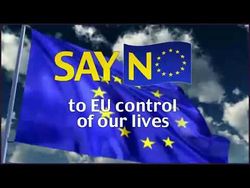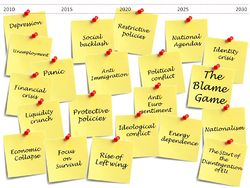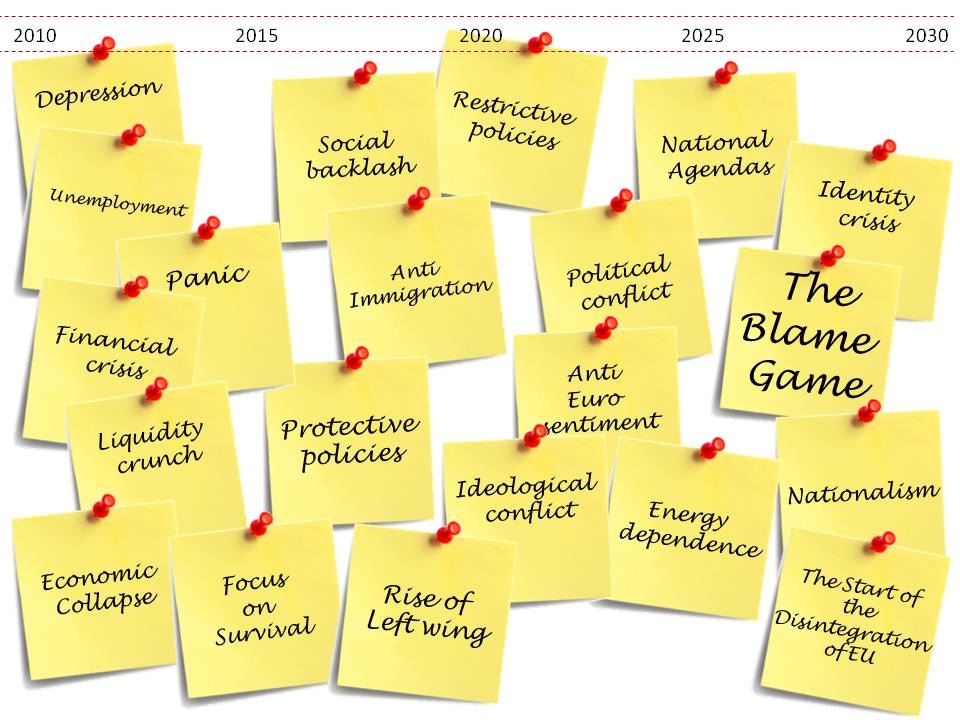The Blame Game
The Scenario
The year is 2030 and the European Union is only a shadow of its glorious past. The region is still feeling the impact of the 2009 financial crisis which led to a depression in Europe.
The billions of Euro pumped into the financial market by the richer nations, helped the economy to stabilize in the beginning and it showed signs of recovery. But, the recovery was long drawn and the rich nations were not able to sustain the financial flow and started withdrawing the money released, to divert it to other economic requirements. After all, each country had its own problems to cope with.
The EU was also unable to sustain subsidising the lesser developed member states. This caused wide spent resentments among member nations. With rising unemployment levels and falling standards of living, member nations turned their focus inward and adopted more socialistic practices.
This combination of no or insignificant growth, together with the reduction of money inflows from the EU to some countries generated a situation where countries were unable to sustain good levels of their social programs. The concept of Welfare State became a burden for the entire region and now a large share of the countries' budgets are compromised with those programs. To keep funding those programs there was an increase in taxes, which increased labor costs significantly in the region, making the economical recovery even more difficult because of the external competition.
People started re-looking at their identity. Till that time they believed in a unified EU, but as the EU was not able to keep the ship afloat, richer members considered the option of being the first to part ways so that they could be able to serve their people better.
That was the beginning of the disintegration.
Timeline
Period of 2010 - 2015
In 2010, after showing some early signs of recovery and a return of investor confidence the economy took a nose dive again. This was described by many economists as the dreaded ‘Double Dip’ which occurs in many recessions. The billions of Euros which had been pumped into the economy had shown no signs of being recovered as the consumer confidence stayed low and most companies continued to cut costs with no changes in top line growth. This resulted in a continued rise in unemployment across the union and especially in Spain and the UK. The rise in unemployment led to a further dip in consumer spending leading to more top line erosion for companies which led to more cost cuts and thus a vicious cycle was started which resulted in an even deeper depression. Soon enough, the strain started to show on the balance sheets of the all the major economies of the Union.
The pessimism and panic spread out throughout Europe and a feeling of uncertainty regarding the future explained several actions taken by individuals and governments to protect themselves. With the lack of confidence in the financial sector people started to withdraw their money from the banks. The bank run required immediate intervention from government, but promises that government would guarantee people's deposits did not stop individuals' willingness to hold their money during the turmoil.
There was a general feeling that all governments were not doing what they were supposed to do (protect their country and their people), and protests began to pop out in the most affected countries. The main criticism was the large expenditures in bailing out the financial market with no visible signs of recovery or improvement for those who were most affected.
Some countries collapsed and others were high in debt, not being even able to pay their obligations. Because of that, external investments diminished and small developing countries lost a big share of their money inflows.
With most of the funds diverted to save the financial system in the beginning and then to keep the social services later, investments in sustainable energy were dramatically reduced, especially those coming from Governments. EU was no longer the champion of sustainability. The primary focus was the survival of economies. Most of the companies developing technology in this industry were start-ups and were not able to survive for a long period without those funds. Another measure that influenced even more the investments in sustainable energy were the relaxation of some regulations. Penalties for CO2 emissions were reduced and the prices of CO2 credits went down. The idea was, save the economy first and the environment can wait.
Period of 2015 - 2020
The effects of the economic crisis were still deeply visible throughout the union. The downward trend had flattened out but millions of jobs had been lost. The huge numbers of unemployed started to feel a large amount of resentment at the large number of immigrants within their countries. They blamed them for the lack of jobs and there was a noticeable shift in the mindset of the people with more and more people sharing conservative ideas about closing down borders to immigration and tightening laws for off shoring and outsourcing. This started to cause wide spent resentments among the poorer member nations.
The idea of tightening border controls was first adopted by the richer nations during the depression. The idea behind was to reduce the most visible consequence of the depression (unemployment) and to show to the population that those Governments were doing something to solve the problem.
Another maneuver used by those countries was the increase in import duties. It was against the main policies of the EU, but that was a form that some small countries found to protect their internal markets and, consequently, their companies that were still alive and generating jobs.
Elections in the countries of the EU started to show a rise of left wing parties pushing a more socialist agenda. They blamed the capitalist way for the crisis and came to the conclusion that the socialism with its ideals of equality and fairness was a much better concept. The huge government equities in major companies were leveraged to enforce new labor laws. Protectionism was the flag raised by political parties to receive enough votes in order to remain in the power. Sustainability was not even on the agenda of the left wing.
Period of 2020 - 2025
Socialism had taken a strong hold in Europe with almost all countries being governed by left wing governments. Socialist governments started to blame each other for the economic slowdown of the past decade.
The crisis had also effected countries in several degrees. Many governments wanted to regain control of their monetary policies to devaluate their currencies in order to improve exports and provide a much needed stimulus to their economies. The presence of a unified currency was thus seen as a roadblock to progress by many governments and some countries started to talk about giving up the Euro and going back to national currencies. This uncertainty led to the a loss of confidence in the Euro by the foreign investor community.
The growth of socialism also led most countries to focus primarily on their own national agenda, thus ignoring worldwide issues like climate change, green technology, poverty reduction, immigration and conflict resolutions.
Immigration became harder and most of the countries adopted very tight border controls, generating some tension points between regions. Free trade was also not free anymore, with many countries using import taxes as a protection of their internal markets and industries. It was not desirable to have a money outflow because those funds were required internally to keep the economy moving.
The lack of new investments in renewable source of energy led to a growing dependence on conventional sources of energy such as oil and gas which were becoming increasingly scarce. This led to a greater dependence by most EU countries on Russians resources. Some members developed good relationship with the Russians while others were against the high level of dependence. The difference of interests were becoming bigger among the members.
Global warming was a concern and EU was under pressure from other nations to act upon. But, EU did not have the backing of the socialist governments in power in member nations. This also added to the political tensions within the EU.
Period of 2025 - 2030
Everything that happened during the previous years moved governments to focus more and more towards their own countries. Each country had its own problems and had to take care of its own citizens. There was thus tremendous pressure to spend any extra capital within the national boundaries and as a result these governments pulled back on previously committed funds for foreign aid and development of more impoverished member countries.
As many countries started to pull back funds they started to face a lot of criticism from their neighbors. However, since the situation was the same within their countries and their citizens also started to demand a pull back of foreign aid funds. This invited criticism from other countries and a blame game started to play out over the continent and especially in the European Parliament. The media also started to get involved and each national news agency started to highlight and cover any 'incorrect' move made on the part of any of other country in game of oneupmanship.
As the media got involved, the common people started to get influenced and they started to rethink about the concept of the EU. The longer this situation progressed, the more people started to sink into their own national identities and giving up any concept of a European identity.
It started to become clear that there was no real 'Union' left within the EU anymore and that was the beginning of the disintegration.


